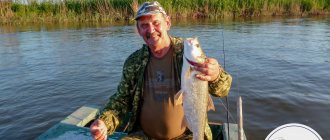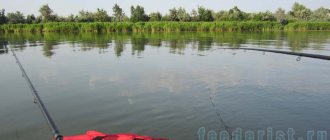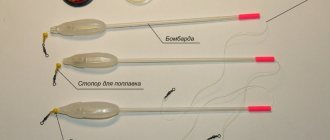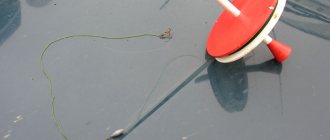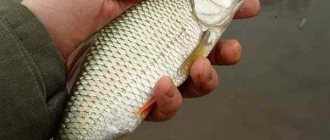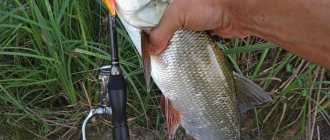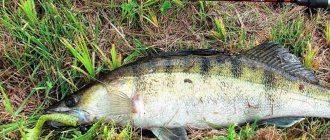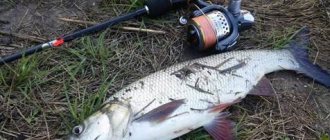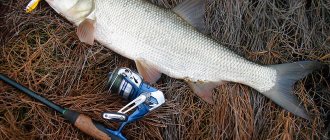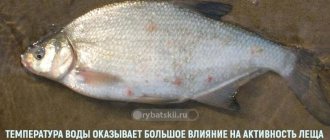In straight sections, the Msta is a typical flat river, 70-90 m wide, with a moderate current, and banks overgrown with willow trees. In the coastal zone there are thickets of pondweed, egg capsules and here and there cattails. The depth gradually increases from the bank to the channel, without forming sharp drops or edges, and averages 2-2.5 m.
The bottom is predominantly sandy or muddy. Below the rocky rifts, at the narrowings of the river, pits up to 3.5-4 m deep are usually formed. The maximum depths in the described areas reach 5 m. Such pits can be found at sharp turns of the river from the outside, under a washed-out steep bank. In some places, the river bottom is completely littered with driftwood - once upon a time timber was floated down the Msta.
The main problem that a spinning angler may encounter on Msta is significant fluctuations in water levels in rainy weather. After several days of prolonged rains, streams begin to rustle along the banks of the river, carrying muddy streams from overcrowded swamps and eroding the sandy and clayey banks. The water in Msta begins to rise rapidly and acquires the color of “coffee with milk”. The current intensifies, uprooting bunches of aquatic vegetation and washing away debris of fallen trees from the banks. During this period, there is nothing to do with spinning on the river. The most unpleasant thing is that the water can rise by more than 1 m in a day, and its level will fall very slowly and it will take a long time to clear of the clay suspension, even if the rains stop.
Therefore, when going to Msta, at least 24 hours in advance by phone, I collect information about the water level on the river from local residents or from relatives and friends vacationing at the dacha. In general, according to my observations, the lower the water level on Msta, the easier it is to find active fish and the more successful the fishing is. For successful fishing on Msta, it is advisable to have a motor boat. Thanks to the mobility of this craft, you can save time when moving from one promising point to another.
I’ve been fishing for many years with an old Kazanka with a reliable and unpretentious Veterok-8 M motor. I don’t recommend using a more powerful engine on Msta, especially in an unfamiliar area, because running into a snag or boulder, of which there are plenty here, is not very pleasant even under a figure eight . Although, of course, fishing from the shore is also possible. Then don't forget to bring a good wading suit with you.
In Msta it is quite wide, although typical for the middle zone. The river is home to pike, perch, pike perch, catfish, asp, chub, ide, bream, roach, silver bream, sopa (white-eye), bleak, quicksand, gudgeon, ruffe, loach, spined loach. Occasionally we come across burbot. Sometimes large schools of large dace enter the river, but this does not happen every year. I know of cases of catching crucian carp, carp and tench in Msta, which apparently escape from the lakes and ponds of the river basin during high water. Old-timers often talk about how fathers caught huge quantities of whitefish in late autumn, salting them in barrels.
Whitefish entered Msta from Volkhov. After the completion of the construction of the Volkhov hydroelectric station in 1926, the path to Msta for whitefish was closed, and this fish disappeared here. It is worth mentioning that on some small tributaries of the Msta you can meet grayling and brook trout. Unfortunately, the populations of these noble fish have decreased significantly in recent years due to fishing pressure and poaching. But despite this, catching a one-kilogram spotted beauty on a rapid forest stream during bird cherry blossoms is still possible and, when using ultra-light tackle, sometimes gives no less pleasure than landing a 10-15 kilogram catfish on Msta itself.
Read: Fishing in winter on rapids
Description of the reservoir
The Msta flows through the territory of the Tver and Novgorod regions. This is a unique reservoir that has the following characteristics:
- river length – 445 km;
- pool area – 23300 sq. km;
- water consumption - 202 cubic meters. meters per second;
- The river's slope changes from north to west.
The source of the Msta River is located in the Tver region. It flows from Lake Mstino, not far from the village of Vyshny Volochyok. It flows into Lake Ilmen, not far from the beginning of the Volkhov, on which Veliky Novgorod stands.
In the upper reaches of the Msta it has a very winding channel with sharp turns and “loops”. Its width in this area is about 40–50 meters, and the average depth is about 2 meters. The shores are mostly flat, the bottom topography is calm.
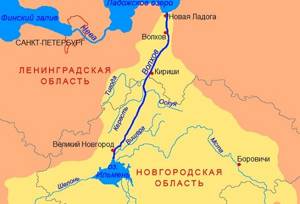
Msta and Volkhov form the Priilmenskaya lowland
In the middle course, the river bed widens to 70–80 meters. In the area between Opechensky Posad and Borovichi, Msta overcomes a system of rapids (about 50), which attract lovers of water tourism. The largest are Bittern, Egla, Ryk, Vitsy, Rovnensky, Bolshoi. The river drop is 54 meters, the current is fast, the depth is from 0.1 to 2 meters.
In its lower reaches, the Msta calms down, becoming a classic medium-sized lowland river, the width of which in this section is about 100 meters. Depths reach 10 meters. The bottom is sandy and muddy, aquatic vegetation is present, and the relief is relatively calm. The last 50 km from the mouth are navigable.
Throughout its entire length, the Msta is fed by tributaries that influence its water level and the nature of the river. The main ones are:
- Birch;
- Reassure;
- Sjögrinka;
- Peretna;
- White;
- Linen;
- Hmmm;
- Kholova;
- Huba.
Below Opechensky Posad, the underground river Poneretka flows into Msta.
For reference! On the banks of the Msta are the settlements of Borovichi, Lyubytino, Msta, Toporok, Opechensky Posad, Bronnitsa, and Ust-Volma.
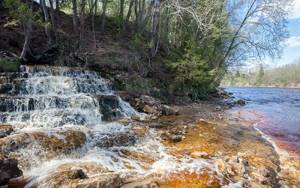
The underground river Poneretka flows into the Msta River
Msta's nutrition is mixed - snow, underground and rain. The river freezes in November and opens at the end of March - beginning of April. The peak of the flood occurs in the first ten days of May. Returns to the shores in mid-June. Summer low water falls at the end of July.
Msta River (Novgorod region)
Published 16 Aug 2014, 23:33
Published 16 Aug 2014, 23:42
Published 17 Aug 2014, 00:22
Published 17 Aug 2014, 00:30
Published 17 Aug 2014, 01:39
Published 19 Aug 2014, 22:42
Mich, that's for sure! We also really liked the river, so we couldn’t resist a second trip.
Having once again drilled into the outback of the Novgorod region, we planned a picnic in advance, combined with fishing on this wonderful river. The choice of location was made with a finger on the map. First we took a ride along the river upstream from the town of Borovichi. Passing the bridge at the exit from Borovichi, my gaze involuntarily caught on the long roll. Repeated attempts to go down to the river did not lead to a stop in our protracted route. For several kilometers the river was one continuous riffle, on which it was not only difficult to catch fish, but also to swim. For lovers of chub and/or fly fishing, it would most likely be a paradise, but I am not trained in such intricacies, so I was looking for a place for feeder fishing. We turn around and go in the opposite direction, i.e. downstream relative to Borovichi. Having wandered through the country roads and forests we find a very nice place, not far from the village of Korshevo. Even someone very carefully prepared the firewood. The place, apparently, was inhabited, but something suggests that it was more likely by farmers than by fishermen - the meadow was mowed very well, and there were no banal slingshots on the shore. Measurement showed that the expectations for the depth were again did not materialize - there was no more than 3 meters on the riverbed, but the current forced the use of 70-80 gram feeders. But we didn’t see any fish that day, except for bleak, and we have enough of this stuff. Here you have a beautiful river and a promising place. The river turned out to be not only beautiful, but also full of character - the fish along the river are distributed very unevenly and, apparently, the closer to the confluence with the Ilmen, the more interesting the fishing. And to test this hypothesis, another trip was planned, but to more fishy places
Published 02 Sep 2014, 23:22
And finally, the long-awaited trip to Msta took place, almost at the end of the vacation. The place was again chosen “with a finger on the map”, but this time the place had to be fishing. We drove towards the village of Bronnitsa, hoping to find a way to the shore. If there were no entrances, we would have gone under the bridge again. But luck was on our side, and turning into the village of Bozhonka among the houses we found ourselves on the shore. almost.
The presence of local fishermen gave hope for the success of the event. After a short wandering in search of a more comfortable place than the bare bank, we found a stunning clearing where we could wave our fishing rods and set a table with various overseas dishes. Measurement showed that the depth on the riverbed was again no more than 3 meters. Remembering the excursion on the ship, we were immediately puzzled by the question: how did merchant ships sail here several centuries ago? Is the river really that silted up? During the day, a local fisherman arrived, from whom I learned that such a depth is the norm for this river, and if there are holes somewhere, they are not significant - the depth differs from the main one by a maximum of 0.5-1 meter. Locals mainly catch pike perch (average - up to 1 kg, but there are also trophies) on a piece of fish, which I later took advantage of
For the sake of the experiment, I mixed 2 different baits: Dunaeva and FishMir, both bream series. Well, I added 0.5 cans of Bonduelca. The daughters actively helped in the fishing process: The fish readily responded to both baits - there were bites constantly. But if Dunaev was targeted by fish of holiday age, then older friends and buddies became interested in FishMir. Replacing the bait confirmed this trend - after several FishMir feeders, the small fish disappeared from the point and more interesting fish began to be caught, but after Dunaev the fish noticeably decreased. I don’t know what this is connected with, but the trend was obvious. Having become interested in stories about pike perch, I decide to equip my existing crocodile for live bait fishing. Only my daughter caught a small pike perch, throwing a piece of fish slightly below the bait spot. The donka caught quite a nice perch. The wife, in turn, managed to catch a little puppy with a spinning rod, twice, which after the photo shoot went to grow up
Who inhabits
Msta is a typical river of the Novgorod region, therefore it is inhabited by most of the fish that live in the Baltic Sea basin, as well as the Neva, Ladoga, Volkhov and Ilmen. The main representatives of the ichthyofauna:
- roach;
- perch;
- pike;
- bream;
- ide
.
In addition to them, the river is inhabited by chub, saberfish, dace, bluefish, and podust. Small fish include gudgeon, loach, ruff, and bleak. Catfish, burbot and pike perch have been repeatedly spotted in the lower reaches.
The Msta River is of interest to fishermen, especially those who like to hunt for pike and ide, since the mentioned underwater inhabitants in these waters grow to decent sizes. More than once I have heard about the capture of toothy predators weighing over 5 kg or red-feathered beauties weighing 2 kg or more.
Fishing
The Msta River is popular among spinning enthusiasts. The best direction for fishing in these places is considered to be a light spinning rod. It allows you to catch both the classic predator, pike and perch, and such specific fish as ide, chub, dace and asp.
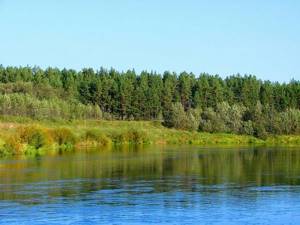
Msta is rich in large ide and commercial pike
The most versatile bait on Msta is considered to be a medium-sized rear-loaded spinner. It is better to choose a model with a blade rotation angle of 30 to 45 degrees, which will allow you to fish everywhere, feeding the spoon in different directions to the current.
When hunting ide and chub, miniature wobblers show good results. In the warm season, when there is a massive emergence of insects, preference should be given to cranks. In cold water it is advisable to switch to minnows and shad.
Advice! On oxbow lakes and branches from the riverbed you can engage in twitching with “adult” wobblers.
Fishing with a microjig allows you to purposefully hunt for perch of various sizes and small pike. If you use medium and large sized rubber, you can expect a bite from a heavy pike, and in the lower reaches of the river - pike perch.
Feeder lovers will not be bored at Msta. Various bottom tackles allow you to successfully catch ide, bream and roach. In cold water, anglers prefer animal baits. The banal earthworm and a bunch of bloodworms showed themselves best. In warm weather, it makes sense to use maggots or switch to vegetable baits - canned corn, mastyrka, dough and steamed wheat grains.
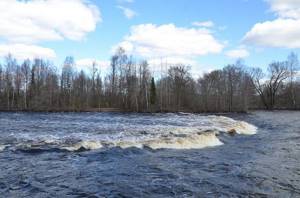
Borovichi rapids attract rafting enthusiasts from all over the country
In winter, on Msta they fish mainly in the lower reaches, mainly in oxbow lakes and other places with a calm current. As for gear, local “penguins” use jigs, vertical spoons and balancers, jigs, and ordinary stationary fishing rods.
Fishing Features
The Msta River is a typical lowland river. In addition, it is subject to strong anthropogenic influence. However, there is excellent fishing here for a variety of fish species. In some areas it is quite possible to catch a catfish weighing more than 10 kg or an asp weighing 3 kg. It is worth noting that in some small tributaries you can catch trout and grayling. Sometimes the size of brook trout can reach 1 kg. When fishing on the main river bed, the most successful fishing is possible when using motor boats. Frequently changing water levels require knowledge of reservoir conditions and mobility. The river, for the most part, flows in an area with a developed transport network, which makes it quite comfortable to get to the reservoir. Tourist rafting is popular on Msta, especially in the area of the rapids. The presence of water obstacles must be taken into account when planning a trip along the river for the first time. As in other cases, when traveling to an unfamiliar area or with your family, we strongly recommend using the services of experienced organizers of recreation and fishing in the area, including in winter. Experienced guides will help you find good fishing spots and organize a comfortable vacation. Don’t forget that there are quite a lot of settlements and historical places on the Msta River, which will allow you to organize interesting leisure time and diversify your trip.
Spearfishing
Underwater hunting on the Msta River is not as popular as on other reservoirs in the region. Firstly, in the upper and middle reaches there is nothing to do due to unsuitable conditions and a small number of large fish. Secondly, in the lower reaches the transparency of the water leaves much to be desired, so diving is not entirely comfortable.
Advice! Within the Novgorod region there are more promising reservoirs from the point of view of spearfishing.
On Msta you can count on shooting a hefty pike and ide. Sometimes it is possible to catch pike perch, catfish and commercial perch, less often bream and carp. The best time to go spearfishing here is the second half of summer or the beginning of autumn, while it is still warm enough.
Asp fishing in Msta
One of the most beautiful and powerful fish in Msta is the asp. The average weight of this fish here is 1.5-2 kg. The largest specimen that I once managed to catch on Msta weighed 6 kg. It is interesting that foals less than 1 kg are very rarely found on Msta. I would call the Mstinsky asp a semi-anadromous fish. In any case, in the area described, it does not stay all year round. The bulk of the asp winters in the lower reaches of the river, and partly, perhaps, in Ilmen.
This fish migrates here in mid-autumn. In the spring, during high water, schools of asp again begin to ascend the river following bleak, their main object of hunting. You can start catching this fish with a spinning rod here by mid-June. By this time, the water usually clears after the flood, and although its level is still quite high, riffles, sand bars and shallows have already become apparent. It is above them that the asp rising upstream will linger.
Although at this time it can be found in the most unexpected places, for example, under the very shore, above aquatic vegetation that has not yet risen to the surface, or in the middle of a wide reach with a decent depth and a seemingly unremarkable bottom topography. But here the asp does not stay long, and its capture is rather random.
Today you can witness a real asp fight and catch a couple of decent specimens, but tomorrow there won’t be a single fish here, since the flock has moved higher up the river. The water continues to fall, and by the end of June its level will stabilize. The asp takes its usual parking places, and its catching becomes more predictable.
On Msta, the easiest way to find an asp is on the doorstep. Moreover, it can hold on both before the drain and in the seething foamy stream below the threshold. The depth here rarely exceeds 1.5 m. Calmer and deeper rifts with a rocky bottom are also favorite parking and hunting places for this predator. Often the asp stays near the steep shore in the shade of the branches of bushes hanging over the water, from time to time making lightning-fast throws from there to catch small things floating by. The largest specimens are usually found at the entrance to the pit, where the depth from 1-1.5 m sharply increases to 3-3.5 m, and the bottom is a pile of boulders.
Unlike pike, a typical ambush predator, the asp is in constant motion. He looks for a victim, and does not wait for her to swim up to him. Therefore, even in mid-summer, migrations of schooling asps down or upstream of the river are observed, although they are more local in nature than at the beginning of the season. From one riffle he likes to another, he moves along the shore, continuing the hunt, so you can catch him while catching another fish with bait that is not intended for him at all.
Read: Fishing for taimen on the rivers of Siberia
